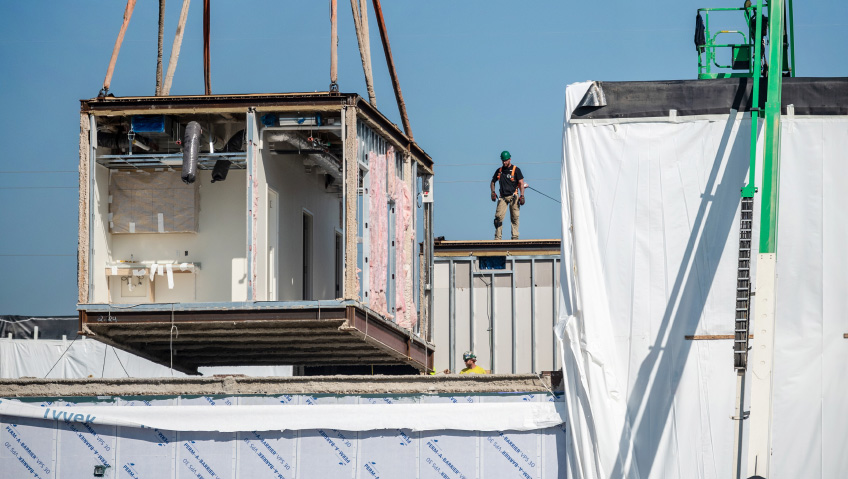Recent reports offer plenty of good news for the modular construction sector in both the United States and Canada. The value of the U.S. modular market was pegged at more than $20 billion in 2024 and is forecast to climb even higher by decade’s end. The Canadian modular market was valued at over CDN$5 billion last year and accounted for 7.5 percent of Canada’s construction market.
This impressive data was compiled by industry research firm FMI Consulting of Raleigh, North Carolina, for the benefit of the Modular Building Institute (MBI). Based in Charlottesville, Virginia, the nonprofit institute represents modular construction companies around the world.
While pleased with the findings, there was “nothing too shocking for me” in the FMI reports, given the popularity of modular construction, says MBI Executive Director Tom Hardiman.
“Everybody’s talking about housing. Local governments, state governments, federal governments… The Canadian government is pushing their Build Canada Homes initiative and modular is at the forefront of it,” states Hardiman, referring to a new Canadian government agency that aims to create more affordable housing.
There are two main types of modular buildings: permanent structures featuring foundations, often used for housing, healthcare, education, or office space. Relocatable modular buildings, as their name implies, are moveable, and this category consists of school portables, temporary housing for workers, emergency disaster shelters, and the like.
Multifamily residential is leading the permanent modular market in America, accounting for $7.1 billion in project value last year, and this is expected to rise to $11.3 billion by 2029, according to FMI’s 2025 United States Permanent Modular Construction Industry Report. Office-use buildings accounted for $1.4 billion in U.S. permanent modular construction last year, and this sector is expected to top $2 billion in 2029. For its part, the relocatable modular market generated $4.7 billion in total U.S. revenues in 2024.
In Canada, the multifamily modular market was valued at CDN$2.16 billion in 2024, followed by the commercial sector at CDN$644 million, education buildings at CDN$495 million, office space at CDN$135 million, and healthcare facilities at just under CDN$100 million, as reported by the FMI’s 2025 Canadian Permanent Modular Construction Industry Report. The reports cited speed to market and cost efficiency as leading drivers of the modular market.
In modular construction, sections of a building are built offsite in a factory. Large modules are shipped to a worksite and put together somewhat like massive building blocks. Steel and wood frames and concrete are the primary materials used in modular construction, and light-gauge steel framing is particularly popular for low-rise modular buildings. Only a handful of modules are needed to complete a structure; traditional construction, by contrast, is primarily conducted at the building site using countless parts and pieces.
Modular construction is safer, speedier, more sustainable, and less expensive than conventional methods, say advocates. Since modular building requires fewer workers and less on-site work, it can help ease soaring housing costs. And modular homes are constructed in controlled factory settings, which is “much safer than working outside, hanging off a building 10 stories up,” adds Hardiman.
Modular construction also produces less waste than traditional construction, which typically generates bins of scrap which are shipped to landfill sites. With modular, leftover lumber and other materials can be set aside in the factory for use in future projects.
MBI has approximately 700 members around the world, the majority of whom are from the permanent modular sector as mergers and acquisitions have reduced the size of the relocatable modular segment. Canada accounts for approximately 80 members, while Europe has roughly 60. Interest in modular building is growing in these regions, says Hardiman, who points to MBI’s recent World of Modular Europe event in Madrid, Spain in October. In Canada, newly elected Prime Minister Mark Carney has promised to tackle housing issues, and Build Canada Homes was launched September 14, 2025, under his auspices. MBI has worked with Canada for years and continues to meet representatives there to talk about the sector.
MBI hosts its annual Awards of Distinction to salute notable achievements by its members. MODLOGIQ, a Pennsylvania-based commercial modular construction firm, took first place this year in the Permanent Modular Healthcare category, for its work on a 100,000-square-foot hospital called the Athens Medical Campus. About 95 percent of this four-story hospital facility was prefabricated in Pennsylvania before being shipped to Athens, Ohio and assembled. Waste was drastically reduced on the project and much of the material was recycled.
“This approach prevented 400 tons of greenhouse gas emissions, recycled 230 tons of materials, and significantly cut project costs,” notes an MBI case study.
“The community got their hospital completed a year early, so it was a great story for the community and our industry,” marvels Hardiman.
On the political stage, MBI continues to grapple with the long wake of the Davis-Bacon Act. Passed during the Great Depression, the act mandated that companies pay local prevailing wages to laborers and mechanics employed on government-funded public works projects. In 2022, the U.S. Department of Labor announced plans to tweak the act so its provisions included modular construction. Given that this would drastically raise costs for the industry, MBI lobbied hard against these changes. The U.S. Department of Labor eventually scuttled plans to modify the act. While this was a victory for MBI at the federal level, the fight continues.
“Unfortunately, what we’re seeing now is a lot of states taking up ‘Little Davis-Bacon’ [Acts]. We had Oregon and New York pass bills this year to expand prevailing wage rates into modular factories for state-funded projects—schools, housing, healthcare,” Hardiman states. MBI is working hard to rescind such bills or convince state legislators not to pass new ones.
Pushback against modular construction might stem from the sector’s growing mainstream acceptance, which threatens the conventional construction industry, Hardiman suggests. MBI runs an initiative called the Modular Advocacy Program (MAP) to raise funds for awareness campaigns. Fundraising has enabled MBI to hire a national public relations firm which arranges interviews and produces news articles; in Canada, another public relations firm performs a similar on behalf of MBI. The institute also maintains a foundation for public education.
The goal of all this activity is to highlight the benefits of modular construction while dispelling stereotypes, since people often confuse modular buildings with trailer homes, for example. These efforts are starting to bear fruit, says Hardiman. “We’re finding more groups like architects, engineers, contractors, are reaching out to us and saying, ‘We have modular on the agenda. Can you speak to us?’ Whereas in the past, it wasn’t on their agenda,” he shares.
In addition, MBI continues its work with the International Code Council (ICC) to implement modular construction standards. MBI is encouraging legislators to adopt standards it has produced in collaboration with the ICC. These include ICC/MBI 1200, which covers planning, fabrication, assembly, and design in off-site modular construction, and ICC/MBI 1205, which concerns regulatory compliance and inspection. These standards have been adopted by Utah, Virginia, and other states.
MBI also has a close relationship with the University of New Brunswick—which features an off-site construction research center—and the American Institute of Architecture Students. In addition, MBI works with universities in proximity to its annual World of Modular conferences and offers scholarships to students who want to attend its annual conference in the U.S. “Last year, we had 50 students come there; we pay for it. We just think, if we want to get the best and brightest students, they should be at the industry conference meeting people,” says Hardiman.
MBI also offers details about careers in the sector as well as job postings as part of its careers in modular construction campaign. “Anyone can send us their résumé and then we try to matchmake with our members. [We provide] a portal for careers in our industry.”
With an eye toward cultivating the next generation of skilled workers, the future looks very bright, with the U.S. modular market forecast to hit $25.4 billion in 2029, based on a 4.5 percent compound annual growth rate (CAGR), according to FMI. The Canadian modular market is estimated to reach CDN$6.4 billion that same year based on a five percent CAGR, adds FMI.
As for further growth potential, Hardiman cites the 2025 Report Card for America’s Infrastructure published earlier this year by the American Society of Civil Engineers (ASCE). While the report focused on non-residential structures such as transit (which earned a D), ports (B), and rail (B minus), it also covered aviation and schools, both of which received dismal D+ grades. When all results were compiled, U.S. infrastructure earned a C overall.
While this is actually an improvement on previous ASCE scores, Hardiman was unimpressed. “We’ve got to do better,” he says. “I’m not suggesting that modular is going to solve all the problems, but I think it’s time to take a fresh look at how we build.”






